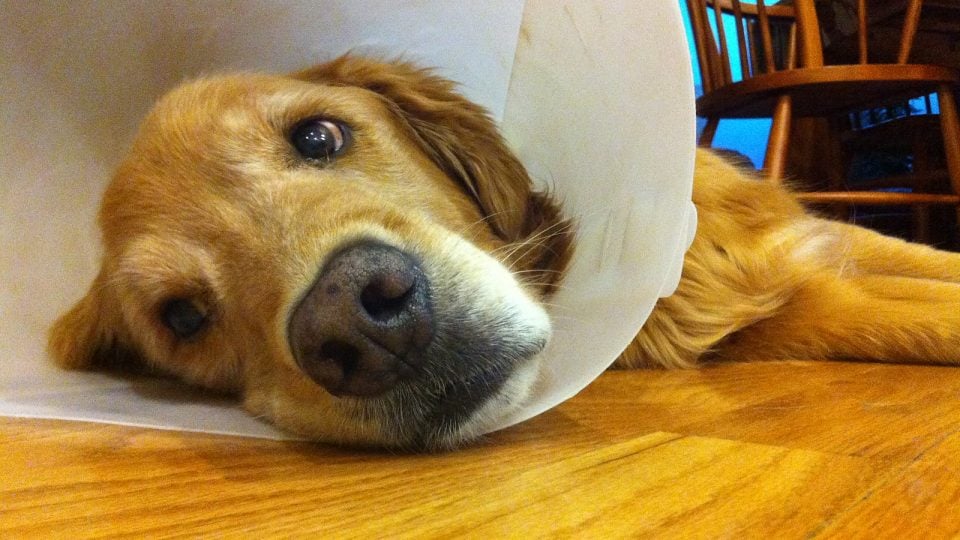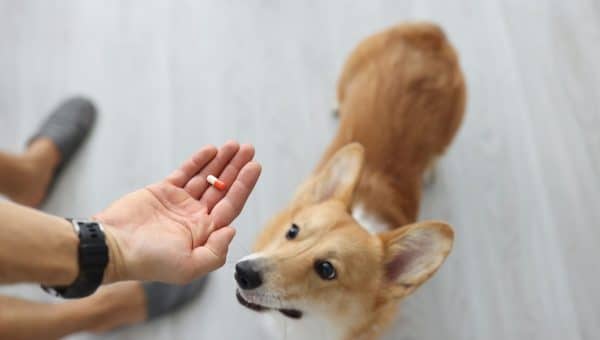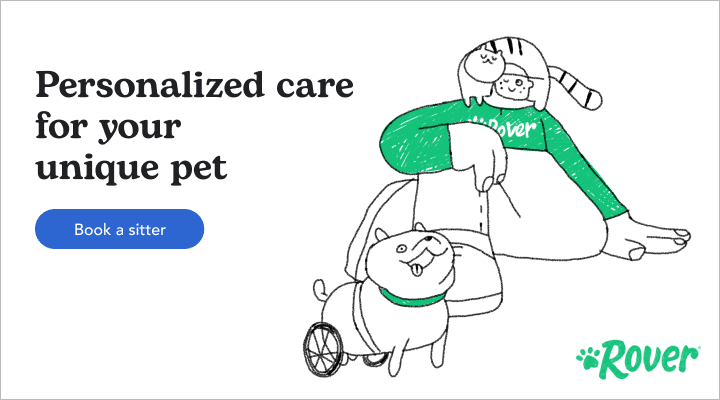- Not a substitute for professional veterinary help.
Your beloved four-legged friend has just returned home after a surgical procedure. So what next? Apart from lots of TLC, a vital element of your nursing duties is looking after their dog’s stitches.
“One of the biggest challenges clients face with dogs after a procedure where sutures are placed is keeping them calm during the recovery process,” explains Dr. Paige Adams, DVM, at Etowah Veterinary Hospital. That’s why the most important stitches care instruction post-surgery is to keep them calm and zoomie-free.
Needle-ess to say, we’ve got all the must-know information to make caring for your dog’s stitches a smooth sailing process.
Caring For Your Dog’s Stitches: The Do’s & Don’ts
Understanding the basics of stitches care beforehand is essential so you – and all family members – can ensure your dog’s healing wound stays clean and healthy. Here are our dog stitches care do’s and dont’s for pet parents.
The “do’s” of post-surgery care
- DO keep them calm and limit activity
- As much as they might not like it, your dog may have to be crated or kept in a smaller room temporarily to help limit their movements. Make the space as cozy and inviting as possible.
- Keep walks short and buy a short leash.
- Swap physical play for mental stimulation – such as treat mazes and puzzle toys.
- Don’t let them jump or climb onto furniture.
- Block entry to staircases (such as with a dog gate).
- DO regularly monitor the area
Frequent checks (two to three times daily) will allow you to quickly notice signs of infection or healing abnormalities. Dr. Adams says mild scabbing is normal. However, she says, “oozing of fluid, swelling, redness, the skin around the area becoming firm, or anything else abnormal” is more cause for concern. - DO give them lots of TLC
We’re sure this is already a given, but bump up those doggy cuddles and nuzzles after surgery to cheer their spirits. - DO follow medication instructions
Alongside stitches, your dog will likely receive painkillers or antibiotics to support their recovery. Stick to the recommended dosages and administration times to aid the healing process. - DO ask for advice if you’re unsure
Remember that your vet is there to help you and your dog, so don’t be afraid to ask questions! It’s also worth discovering your vet’s out-of-hours protocol, just in case an issue arises.
The “don’ts” of post-surgery care
- DON’T let the stitches get wet or dirty
Keep the area clear from dirt and debris, and prevent your dog (and other pets) from licking the stitches. Dr. Adams says pet parents should keep the stitches dry and only clean them with the correct products, such as Hibiclens diluted with water. Additionally, pet parents should avoid giving their dog a bath until the stitches dissolve or are removed. - DON’T take off the “cone of shame” early!
Albeit with the best intentions, Dr. Adams says removing the Elizabethan collar too early after surgery is a mistake by many pet parents. If you remove the cone too early, the stitches might break. From there, the wound area may have to be re-stitched or left to heal on its own – which takes even longer – and your pup might need antibiotics if infection sets in. - DON’T leave your dog unsupervised with other canines
If your pup always runs to their BFF as soon as they enter the dog park, take steps to keep them apart. As much as your dog might love playtime, excited or rough antics can lead to irritated or torn stitches.
What Do I Do If My Dog Is Licking Their Stitches?
If you’ve ever had stitches, you might know they can start to feel annoyingly itchy! This itching arises because histamine cells are a big part of skin healing. The same process occurs in dogs – and they will often lick the area to try and ease the sensation.
The best way to prevent their tongue from reaching the stitches is to give them an Elizabethan collar or bodysuit to wear, says Dr Danielle Rutherford, VMD, associate veterinarian at Westside Veterinary Center.
If your dog does manage to lick or bite at their stitches (because sometimes even the best prevention efforts fail us!), don’t panic. Speak to your vet about whether the stitches need to be redone, and watch for signs of infection. “If the area appears red, inflamed, swollen or painful, it is best to have the incision checked to rule out an infection and start proper preventative care for further damage,” Dr. Rutherford explains.

iStock/alex_ugalek
How Long Will It Take For My Dog’s Incision To Heal?
Like humans, the overall healing process in dogs can vary according to the size and severity of the wound and surgery. However, for stitches, the recovery time isn’t too long. Dr. Adams says in most cases, healing takes 10-14 days.
The duration in which stitches remain also depends on the type of stitch used. The vet removes non-dissolvable stitches when the wound has healed, usually around two weeks post-surgery. On the other hand, dissolvable stitches “break down” and fall away at different speeds depending on their material. “Monocryl, a popular monofilament absorbable suture material, lasts about 14 days before it begins to break down,” Dr. Adams says. Meanwhile, “PDS, another popular monofilament absorbable suture, lasts about six weeks before starting to break down.
Healing Stages of Dog’s Stitches
We all know that stitches (unfortunately) don’t work their restorative magic overnight. But did you know there are four stages to the wound healing process?
- Inflammation. This first phase involves the “blood vessels leaking fluid that causes local swelling, helping to control bleeding and prevent infection,” Dr. Rutherford explains. While it sounds scary, it’s normal! The inflammation process transports the healing cells to the incision site.
- Debridement. Normally, incisions made during surgery are “clean”; Dr. Rutherford says there should be no need for this phase in such circumstances. However, debridement may be necessary if a wound occurs due to an accident. She says it involves removing dead tissue cells and can be achieved using a wound dressing.
- Repair/Proliferative. Dr. Rutherford says this stage is when wounds are rebuilt using collagen. Additionally, she explains that the wound contracts, and new tissues and blood vessels are built.
- Maturation. Dr. Rutherford says this final stage starts about 21 days after surgery and can continue for up to a year. During this time, she says collagen fibers rearrange, reducing the thickness of the scar and strengthening the skin around the incision.
What Are the Types Of Dog Stitches?
There are two types of stitches: dissolvable and non-dissolvable. Different materials are used to make these stitches, and the vet will select the suture type according to various factors. Dr. Adams chooses sutures based on the needs of the tissue, healing times, tension, and the dog’s personality/lifestyle.
Dissolvable stitches
These stitches break on their own. Also known as absorbable sutures, Dr. Adams says this stitch is often the preferred type. As they don’t need removing later on, they’re ideal for surgeries within the body, such as spaying and neutering, intestinal surgery, or bladder surgery.
Aside from surgery, there’s another scenario in which dissolvable stitches are beneficial: treating particularly anxious dogs. Since these stitches dissolve, Dr. Adams says these dogs don’t need to be handled as often and have a lower stress recovery.
Non-dissolvable stitches
Adams says non-absorbable stitches are most commonly used for closing the skin, where the sutures are removed once the area is healed.
However, she adds, this type of stitch can also be used when vets need the suture to stay in the same place. For example, Dr. Adams explains some hernia repairs require non-dissolvable stitches – because if the stitch dissolves or is removed, the hernia will reopen.

iStock/cmannphoto
What Should Healthy Stitches Look Like?
When checking your dog’s stitches and the wound area, it can be tricky to tell what’s “normal” or not. Dr. Rutherford says these are some signs of healthy stitches:
- The area should be clean, and the edges of the skin opposed [against] and touching each other
- A small amount of redness or bleeding after surgery is normal, typically going away after 1-3 days
- A small amount of bruising can occur in the first few days after surgery and should be monitored to check it doesn’t worsen.
What Do Infected Or Abnormal Stitches Look Like?
If your dog’s stitches or the wound area shows any of the following signs, Rutherford says you should contact your vet straight away:
- Discharge that is yellow, green, or white in color, as this can indicate infection
- If any stitches are missing or open, or if there is continued leakage from the surgical site for over 24 hours
- If the incision feels excessively hot to the touch or has a foul smell.
In most cases, dog surgeries are straightforward and complication-free. By providing your dog with plenty of time to rest and ensuring their sutures stay clean and dry, you can help them return to their fun-loving selves in no time.



